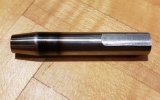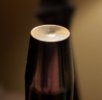9
9.3X62AL
Guest
Made up a 25 caliber GC flaring tool yesterday using The Ben Method (1/4" hex bolt/hacksaw/file). Going slowly, since the ball game was on, I had specs where I wanted them in 30 minutes. It does a fine job on the checks.
Rick's method has appeal also--no place on the existing bench to mount the grinder, though. Maybe I could jury-rig the grinder to a Workmate. Dunno.
I suppose my baseline annoyance here is with the GC makers--in particular Hornady, who advertises their wares as being "crimp-on". Since the things are being crimped on to the shank, why not make them with a bit more flare than what they (don't) have now? Makes ya wonder if the folks making these things have ever used their products in the real world. Just another shooting product that the buyer has to finish making in order to use properly, which is becoming a thematic element throughout this hobby field. Much of what we buy and use in this sport should more properly be sold as a kit item, "semi-finished", with warnings like "Some assembly may be required" clearly posted in ads and on packaging. Rant concluded.
Rick's method has appeal also--no place on the existing bench to mount the grinder, though. Maybe I could jury-rig the grinder to a Workmate. Dunno.
I suppose my baseline annoyance here is with the GC makers--in particular Hornady, who advertises their wares as being "crimp-on". Since the things are being crimped on to the shank, why not make them with a bit more flare than what they (don't) have now? Makes ya wonder if the folks making these things have ever used their products in the real world. Just another shooting product that the buyer has to finish making in order to use properly, which is becoming a thematic element throughout this hobby field. Much of what we buy and use in this sport should more properly be sold as a kit item, "semi-finished", with warnings like "Some assembly may be required" clearly posted in ads and on packaging. Rant concluded.
Last edited by a moderator:



